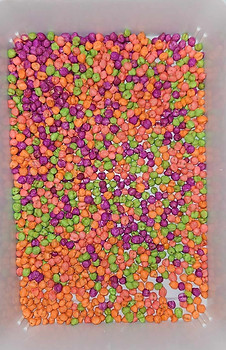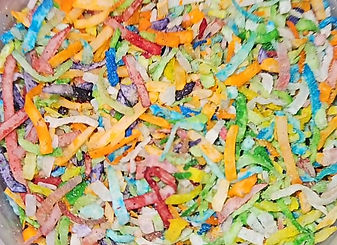

Sensory play is vital for children's learning and development as it provides hands-on experiences that enhance brain development and support various learning domains that are key to their growth. Sensory play supports the development of children’s physical, cognitive, social, and emotional skills.
Messy sensory activities, such as water or slime play, allow children to explore textures and sensations, encouraging problem-solving and experimentation. These experiences also support language development as children describe their sensory experiences and express their ideas. Children explore the properties of different materials, which stimulates their scientific thinking and curiosity about cause and effect
Dry sensory materials like rice, pasta, and chickpeas help children refine fine motor skills as they scoop, pour, and manipulate objects, enhancing their hand-eye coordination and concentration. Also practicing important skills such as sorting, categorizing, and problem-solving. These activities also promote mathematical thinking as children learn about quantities, measurements, and patterns.
Additionally sensory play helps in regulating emotions, providing a calming effect and creating opportunities for children to engage in independent or collaborative play. Through these various forms of sensory play, children not only learn through their senses but also develop resilience, creativity, and social skills, fostering a strong foundation for lifelong learning.In addition to cognitive and physical development, sensory play supports emotional and social development. It creates a safe space for children to express their emotions, build confidence, and develop social skills by sharing materials and collaborating with others.
Sensory experiences can also be incredibly calming, providing children with a way to regulate their emotions and build resilience in the face of new or challenging situations. Furthermore, sensory play encourages creativity and imagination, which are crucial for early literacy and problem-solving. These experiences help children build foundational skills that promote positive learning outcomes, supporting the key EYLF principles of learning through play, holistic development, and play-based learning that cater to the diverse needs of every child. Through sensory play, children not only explore their environment but also strengthen their ability to think critically, interact with others, and develop essential life skills.


Coloured Chickpeas
Sensory coloured chickpeas are an excellent resource for children's learning and development. Their unique texture and vibrant colors engage children’s senses, promoting tactile exploration and fine motor skills as they pick up, pour, and sort the chickpeas. This activity helps enhance hand-eye coordination and supports cognitive skills such as color recognition, sorting, and categorizing. Sensory chickpeas also encourage creativity and imaginative play, allowing children to create patterns, designs, or even stories. Additionally, the calming nature of this sensory experience can help children regulate emotions and focus, making it a beneficial tool for both independent and social play.
Coloured Sensory Rice
Sensory coloured rice is a fantastic tool for children's learning and development. It engages their senses through vibrant colors and textures, offering a hands-on experience that enhances fine motor skills as they scoop, pour, and manipulate the rice. This activity promotes creativity, as children can explore patterns, sorting, and color recognition. Sensory rice also supports cognitive development by fostering problem-solving skills, encouraging children to explore cause and effect as they interact with different materials. Additionally, it provides a calming, focused environment for children to regulate their emotions, making it an excellent choice for both independent and group play.




Themed Sensory
Christmas, Halloween, and Easter are perfect times for a sensory activity. Its vibrant colors, paired with the delightful scents of holiday-themed oils or spices, create an engaging and immersive sensory experience. The seasonal scents, such as cinnamon for Christmas, pumpkin for Halloween, or floral for Easter, enhance the experience and help create a festive atmosphere. Sensory activities also encourages creativity, pattern making, and imaginative play while supporting cognitive development, making it a fun and beneficial activity for children during holiday celebrations.
Coloured Coconut
Sensory coloured coconut is a delightful and engaging material for children's learning and development. Its soft texture, bright colors, and sweet fragrance stimulate multiple senses, offering a rich sensory experience. As children explore the coconut, they enhance their fine motor skills by scooping, pouring, and manipulating the material. The sweet smell adds an extra layer of sensory input, which can be calming and soothing. This activity encourages creativity, sensory exploration, and imaginative play, while also supporting cognitive skills like color recognition and sorting.
